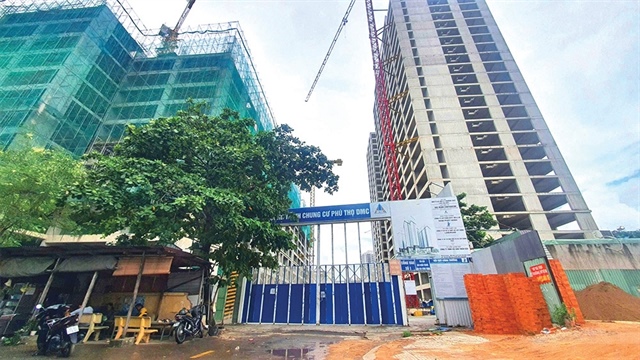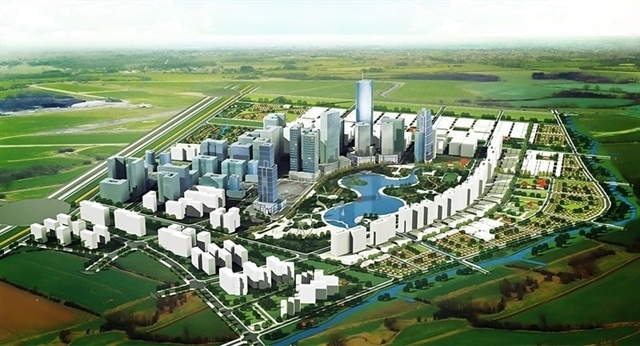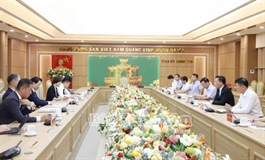Social housing still out of reach for low-income earners
Social housing still out of reach for low-income earners
Despite growing demand for social housing, particularly in major cities like Ho Chi Minh City and Hanoi, the supply remains bottlenecked due to various regulatory, procedural, and policy barriers.
According to the Ministry of Construction, the country needs to build at least one million social housing units by 2030 to meet the housing needs of low-income earners and workers in industrial zones.
To date, Vietnam has completed only 108 social housing projects, equivalent to approximately 73,000 units. Compared to the 2030 target, the country has just five years left to account for 93 per cent of the plan.
“Despite numerous policies, directives, support measures, and commitments, the scheme remains far behind its goal,” said Nguyen Van Dinh, chairman of the Vietnam Association of Realtors (VARS).
Dinh pointed out that the lack of a breakthrough in social housing supply stems largely from shortcomings in development policy. Among them, three major issues have yet to be effectively addressed.
One key challenge is that many localities have not allocated adequate land for social housing development. In some areas, land has been set aside but lacks essential infrastructure, rendering it unsuitable for project implementation. Additionally, the absence of effective mechanisms to mobilise private land resources for social housing continues to be a significant bottleneck.
Investment procedures and the selection process for developers of social housing projects are also overly complex.
Dr. Su Ngoc Khuong, senior director of Investment Advisory at Savills Vietnam, said that approval processes for social housing are not much different from those for commercial housing projects, and are sometimes even more complicated due to additional layers of scrutiny.
“Combined with low profit margins, this has discouraged developers from entering the market,” said Khuong.
The current capital and credit mechanisms for social housing are also inadequate. Most projects still rely heavily on developers’ equity and commercial bank loans. Although a $4.8 billion credit package has been introduced, interest rates and loan tenures remain unattractive for both developers and low-income buyers.
Moreover, many localities lack supportive mechanisms to facilitate project implementation and have not integrated social housing targets into their housing development strategies. Meanwhile, the process of identifying eligible beneficiaries remains inconsistent and confusing.
Certain groups, such as seasonal workers, military personnel, and those with incomes just above the eligibility threshold, are effectively excluded due to administrative or financial constraints, including the requirement to have permanent or temporary residence status, or the need to provide a 20 per cent down payment, which is challenging for low-skilled and young workers with little savings.
“Social and affordable housing planning is frequently discussed, but in practice, supply remains insufficient. The city is facing multiple challenges related to planning, land availability, and transportation infrastructure,” added Khuong.
To address current difficulties, the VARS suggests that local authorities should proactively allocate specific, suitable land for social housing and integrate this into their five-year and annual housing development plans. To encourage developer participation, investment approval procedures should be streamlined, and the developer selection process simplified through transparent and public bidding mechanisms.
In terms of funding, the establishment of central and local-level social housing development funds is essential. These can be sourced from land use fees, the state budget, and contributions from businesses and industrial parks.
Local governments also need to implement tailored policies aligned with local needs, such as promoting rental housing, diversifying models, accurately targeting real demand groups, and strengthening inspection and supervision to prevent policy abuse.
Regarding beneficiary policy, it is necessary to increase transparency and simplify procedures for identifying eligible buyers or tenants, shifting from a pre-approval to a post-audit mechanism. Supportive policies should be introduced for lease and rent-to-own models aimed at workers unable to afford home purchases. A national database on social housing should also be developed to ensure fairness, transparency, and consistency in access.
Dr. Khuong emphasised that sustainable social housing development requires clearly identifying land reserves and assigning development tasks to investors based on key performance indicators agreed upon between government and business. Legal, credit, and profit margin support must also be provided.
“If we can remove these bottlenecks, particularly in credit access and preferential interest rates for both businesses and eligible buyers, while introducing targeted mechanisms, only then can we ensure an adequate and stable supply,” he said.
From a sociological perspective, Khuong also warned of long-term consequences if social housing continues to remain inaccessible to the public.
“When people do not have a stable place to live, it can lead to significant social problems. From a developmental sociology standpoint, this is a serious challenge facing many developing countries,” he said.

Social housing still out of reach for low-income earners, Photo: Le Toan |
Dr. Nguyen Sy Dung, former Deputy head National Assembly Office
Despite numerous efforts, the development of social housing still requires continuous supplementation and improvement to meet rising demand.
One significant step forward was the passage of Resolution No.201/2025/QH15 in May, which allows for the pilot implementation of specific policies for the development of social housing.
Also, in February, Decision No.444/QD-TTg assigned annual social housing targets for 2025 and the following years up to 2030, to be incorporated into local socioeconomic development indicators.
However, the challenges remain in terms of institutions, planning, land access, and financial resources. The implementation of this policy requires significant efforts from the local authorities, and proactive supports from the central government, particularly through the newly adopted resolution.
Nguyen Van Sinh, deputy Minister of Construction
The development of social housing is a critical policy closely tied to social welfare. It not only addresses the housing needs of the population but also promotes the supply of reasonably priced homes, thereby contributing to a safe and healthy real estate market.
Recognising this importance, the Party, state, government, and the Prime Minister have all issued clear and consistent directives to accelerate social housing investment and development.
Numerous nationwide conferences, official documents, resolutions, and directives have been issued to urge ministries, sectors, local authorities, and businesses to take part. Many localities have made significant efforts in implementing social housing projects and have achieved notable progress.
In terms of institutions and policies, the National Assembly has passed a comprehensive package of key legislation. The Housing Law now includes provisions for housing for armed forces personnel and expands social housing development policies. Housing development targets have also been assigned to local authorities.
In terms of practical implementation, under the Prime Minister’s directive, localities have proactively taken action. Nationwide, over 1,300 locations have been zoned for social housing covering over 9,700 hectares.
As a result, nearly all localities have allocated sufficient land funds for social housing development. Many have prioritised reserving land in convenient locations, near urban centres and industrial zones, while ensuring that technical and social infrastructure is in place to support these developments.
Le Hoang Chau, chairman Ho Chi Minh City Real Estate Association
Within the special policy mechanisms for social housing, we recognise two prominent policy groups.
The first is the decision to establish the National Housing Development Fund. This fund institutionalises the directive on the development of affordable housing in urban areas. It is a strategic directive that has now been codified into policy.
For the first time, through this fund and a number of provisions in Resolution 201, housing for public servants and state employees is being formally addressed, something that was not clearly regulated in the 2023 Housing Law.
Previously, public servants had to enter lotteries for the opportunity to purchase social housing units, sometimes drawing a blank or missing their chance due to time constraints. In the near future, the government is expected to issue a decree to concretise Resolution 201.
The second key area is investment in technical infrastructure that connects to social housing projects. While project developers are responsible for building on-site infrastructure, there remains a need for supporting transportation links and public utilities. Resolution 201 clearly states that the fund will invest in both technical and social infrastructure. Social infrastructure includes parks, green spaces, schools, hospitals, and commercial services. Importantly, the fund will also support the development of social rental housing, which is a highly appropriate and forward-looking direction.
The second policy group comprises exceptional mechanisms, and a highlight is the radical reform of procedures for investment and construction of social housing projects. This reform will shorten the administrative process by 350 days.
According to current state regulations, this is the expected reduction, but in practice, we believe it could reduce the timeline by more than 1,000 days, cutting at least three years off the procedural duration required to develop social housing projects.
- 10:18 29/07/2025




























